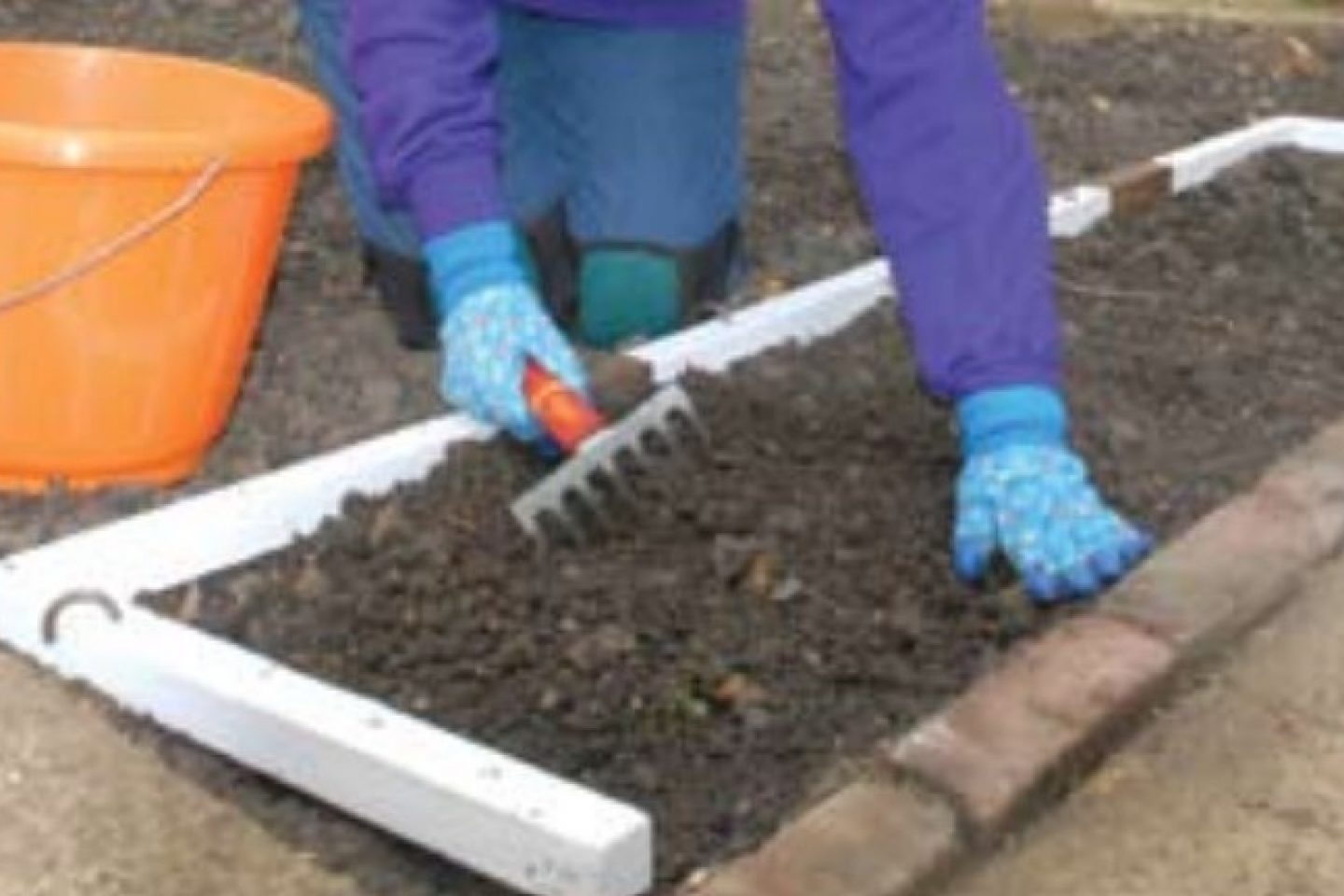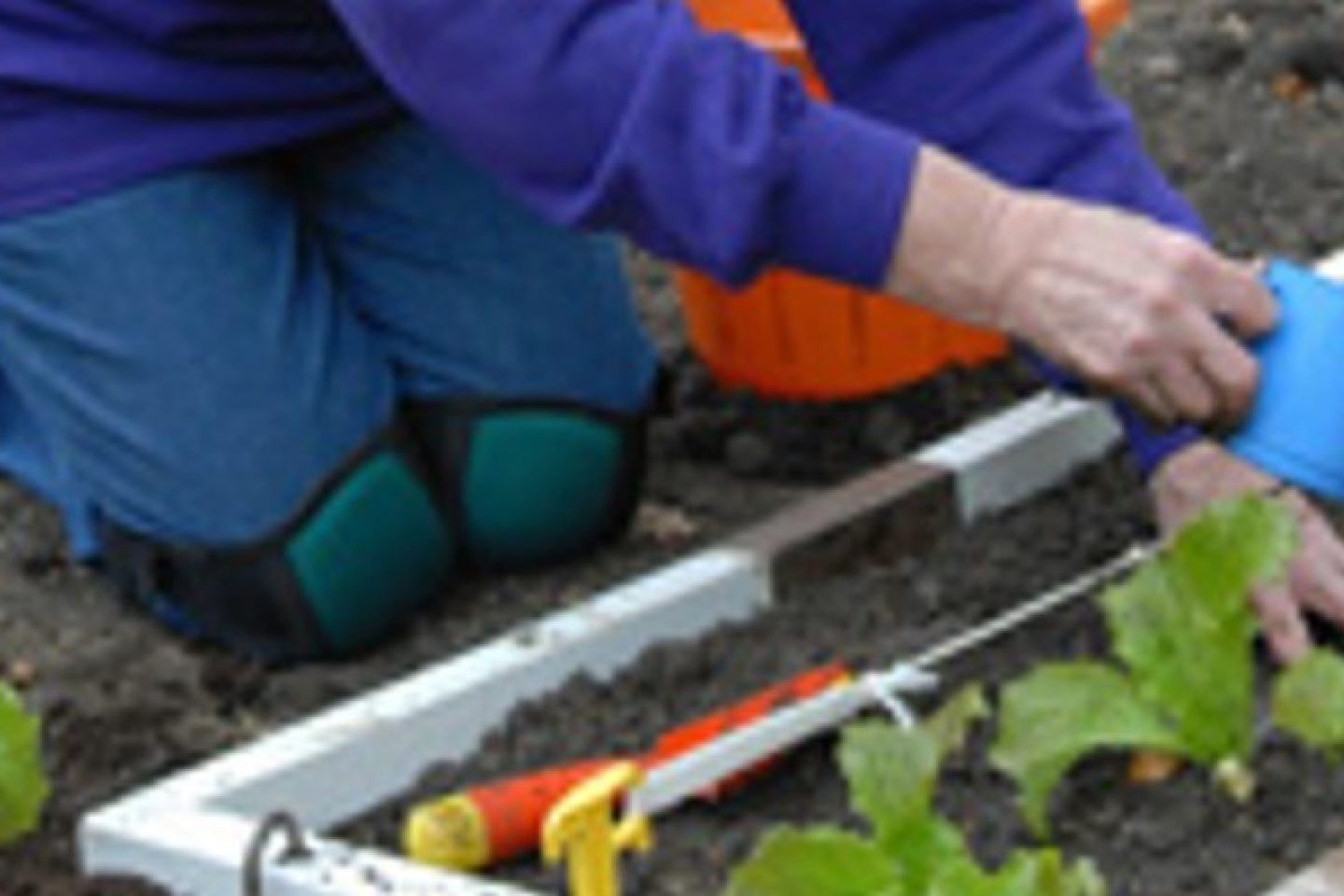
The right-angle guide was devised by a blind gardener in the late 1960s. Many blind or partially sighted gardeners now find it an essential tool.
You cannot buy a right-angle guide from a shop or garden centre, it is something you will need to make at home (see below). It is made either of plastic or wood.
A right-angle guide can take slightly different forms. It can either be a simple L-shape, or two right angles can be connected to make a ‘U’ shaped guide. The sides are marked with studs or screws, which helps when working out planting distances.
Constructing a right-angle guide, whether from plastic or wood, does require some detailed processes including cutting and gluing with strong solvent. You may want some help from a skilled craftsperson.
Download a PDF with instructions for making a right-angle guide.
Right-angle guides are helpful for several different gardening activities. Here are some of the ways you could use yours:
Digging, forking and raking beds and borders

Before planting in beds and borders, it is best to prepare the soil. This can involve lightly digging / forking it over and raking it.
Peg down your right-angle guide to mark where you will begin forking. Gradually move the guide across the complete area of the plot, feeling as you go.
Once you have finished forking, you can start raking. It may work best to kneel outside the guide and rake using a sweeping action backwards and forwards over the soil. Remove any large stones into a bucket and use your free hand to check your progress you are making.
When you are satisfied that the area is fairly level, move the guide on to the next section. When you are finished raking, your plot is ready for planting.
Read our guide to preparing beds and borders for more advice.
Planting out

Your right-angle guide can help you plant nice straight rows of vegetables or flowers.
Peg the guide down at the end of your plot. Studs on the guide arms mark 10cm, 20cm, and 30cm in from the end of the plot. Run a garden string line all the way across your plot, starting from one of these distance markers.
Use this string line as a guide for planting straight rows. Space your plants out at distances suitable for how big they will grow. Seed packets usually say how far apart to space plants. You could make knots in the string at even intevals to help feel spacing.
When you plant, kneeling outside the guide and face the area you are planting in. Feel along the string to the correct spacing. You could use a trowel or bulb planter to make planting holes. Keep the string line between you and the plants. This way, you will not accidentally move the newly added plants when you move the string.
Once you have planted the area inside the guide, you can move it to the next position. Try to work methodically and to plant and water each plant before moving onto the next one.
Raking and feeding the lawn
For this, a 1-metre long connector between the two right-angles can be helpful, particularly if applying feed.
Peg your guide so it faces into your lawn. If there is a path beside your lawn, you could peg it next to this.
Work within the guide and thoroughly rake the lawn with a leaf rake or spring tine rake. Rake working backwards from one end of the area inside the guide. The lawn rake should almost fill the width of the guide.
When you reach the end, depending on the time of year you may find there are plenty of leaves and other debris to be gathered up into a bucket.
You could aerate your lawn at the same time. You only need to aerate a lawn every couple of years, though. To do this, go back to the beginning of the guide and push a garden fork into the soil. Keep doing this at around 15cm intervals across the whole guide area.
If you are also feeding the lawn, add feed evenly over the guide area. You are now ready to move the guide onto the next position.
It may take rather a long time to cover your whole lawn. But, the end results will be worth it!
Read our guide to raking the garden for more advice.
Sweeping outdoors
If you are blind or have sight loss, you may find it easiest to sweep hard areas of the garden by kneeling and using a dustpan and brush.
For large areas, a right-angle guide can be useful to keep track of where you have been working.
Read our guide to sweeping outdoors for more advice.
Weeding
If you have sight loss, identifying weeds can be particularly challenging. Planting in blocks or lines can help make it easier to tell the wanted plants from the weeds (see planting out above).
When weeding beds and borders, it may be easier to weed kneeling at ground level. A right-angle guide can help keep track of where you have been working.
Right our guide to weeding for more advice.